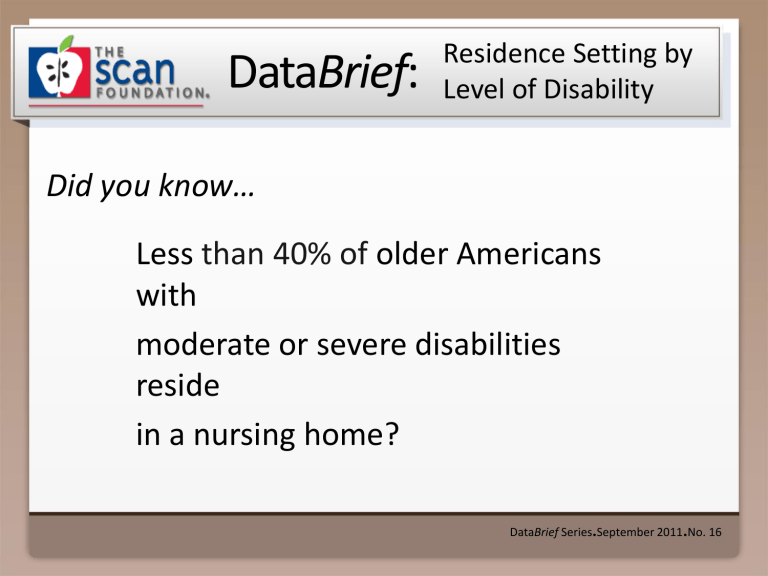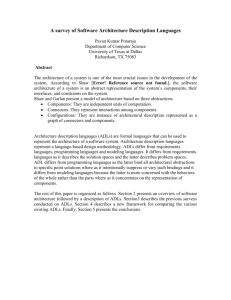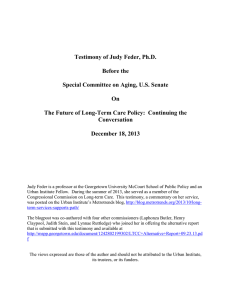databrief_no_16 - The SCAN Foundation

DataBrief:
Residence Setting by
Level of Disability
Did you know…
Less than 40% of older Americans with moderate or severe disabilities reside in a nursing home?
DataBrief Series
●
September 2011
●
No. 16
Residence Setting by Level of Disability
• Levels of disability are measured by Activities of Daily Living (ADLs). ADLs are basic personal care activities including bathing, dressing, transferring to and from a chair or a bed, using the toilet, and eating.
• Individuals with moderate or severe disabilities require assistance with 2 or more ADLs.
The federal government, states, and private long-term care insurance (LTCi) often use this benchmark to define benefit eligibility for long-term services and supports (LTSS).
1,2
• Most people with moderate or severe disabilities prefer to receive LTSS in their homes or apartments, or in residential care settings like assisted living facilities, domiciliary care facilities, or continuing care retirement communities.
3
• As a result, most states have significantly “rebalanced” LTSS spending to the community;
58% of older Americans who require assistance with 2 or more ADLs reside in either the community or residential care settings while 38% of this group reside in nursing homes.
4
1 Kaye, Stephen, Charlene Harrington and Mitchell LaPlante. “Long-Term Care: Who Gets It, Who Provides It, Who Pays, And How Much?” Health Affairs,
29(1)
3
(2010): 11-21.
2 Most LTCi plans set their benefit trigger at 2 ADLs out of a total of 6 ADLs including: eating, bathing, dressing, toileting, transferring, and continence.
Alexcih, Lisa. “Nursing Home Use by the Oldest Old Sharply Declines.” Lewin Group, 2006.
4 Avalere Health, LLC, analysis of the 2006 Medicare Current Beneficiary Survey Cost and Use file.
DataBrief (2011) ● No . 16
Page 2
Only 38% of Older Americans With Moderate or
Severe Disabilities Reside in Nursing Homes
Percent of Individuals Living in the Community or in Facilities by Level of Disability, 2006
3%
100%
90%
80%
70%
60%
50%
40%
30%
20%
10%
0%
97%
8%
10%
81%
1%
38%
9%
49%
3%
Nursing Home
Residential Care
Community
Other*
0 ADLs
N = 32 million
1 ADL
N = 1.3 million
2 or more ADLs
N = 2.6 million
* Includes hospitals, rehabilitation facilities, and homes for people with developmental or intellectual disabilities.
DataBrief (2011) ● No . 16
Page 3
About the data:
This analysis is based on the 2006 Medicare
Current Beneficiary Survey (MCBS) Cost and
Use file, an annual, longitudinal survey of a representative sample of all Medicare enrollees. The MCBS contains information on residence setting and level of disability. It includes interviews with people in the community setting and in long-term care facilities.
In this analysis, respondents who indicated that they received help or standby assistance with eating, bathing, dressing, toileting, and transferring were considered to have ADL needs.
Residential care includes assisted living facilities, domiciliary care facilities, continuing care retirement communities, and other types of residential care facilities.
This analysis is limited to individuals age 65 or older who are enrolled in the fee-forservice, or traditional, Medicare program. It excludes beneficiaries who were enrolled in
Medicare managed care at any time during the year.
A Clear Policy Connection
Most individuals with moderate or severe disabilities prefer to receive LTSS in their homes and communities. As a result, there has been a “rebalancing” of
LTSS provision to this setting over the last two decades. In 2006, 58% of older
Americans with this level of disability lived in community settings.
Rebalancing of LTSS began in the 1980s and was further encouraged by the
Supreme Court ruling in the case of Olmstead vs. L.C. that “the unnecessary institutionalization of people with disabilities is a type of discrimination prohibited by the Americans with Disabilities Act.” Therefore states must operate programs in a way that does not unnecessarily force an individual to move into a nursing home or other institution.
1
Federal policy continues to support individuals with disabilities to remain in the setting they prefer. Recently, the Affordable Care Act includes opportunities for states to receive additional funding to help individuals transition from nursing homes to community-based settings. One such program is the State Balancing Incentive Payments Program (BIPP), which will provide enhanced Medicaid funding to states devoting less than 50 percent of their total Medicaid spending to HCBS to increase this proportion beyond specific benchmarks. This program is scheduled to operate from October 2011 through September 2015.
Analytics powered by Avalere Health LLC
1
National Senior Citizens Law Center. 10-Plus Years After the Olmstead Ruling: Progress, Problems, and
Opportunities. September 2010. Accessed July 19, 2011 http://www.nsclc.org/about-us/nsclc-in-thenews/NSCLC%20Olmstead%20Report%20-large%20text.pdf.
DataBrief (2011) ● No. 16
Page 4









